When LEGO creates minifigs, they are by default assumed to be white individuals of Western European descent. However, there have been numerous themes and sets over time in which some or all of the minifigs are explicitly created to represent individuals of a specific culture or geographic region. For example, minifigs in the Chinese New Year theme are meant to represent Chinese folks.
In this analysis, we explore which cultures have been represented, how they have been represented, and how representation has changed over time. It is problematic in itself that the default ethnicity of minifigs is Western European, and anything non-European or representing a more specific European culture (e.g. French) is explicitly defined with features to highlight their culture. However, beyond this fundamental structure that creates a divide between Western European and ‘other’ cultures as well as establishes generic Western European as the default, we seek to understand which cultures or regions have been excluded completely, and of the ones that have been represented, are they represented in a way that honors the culture or in a way that misrepresents or disrespects the culture?
Additionally, we explore the interplay between gender equity and cultural representation through an analysis of the distribution of male-female-neutral minifigs within the subset of culturally-inspired minifigs.
LEGO has created two themes based on their own TV series, Ninjago and Monkie Kid, which are inspired mainly by Japanese and Chinese cultures, respectively (although Ninjago has evolved to include a mashup of cultures). Given that there are over 400 Ninjago minifigs and about 50 Monkie Kid minifigs, these two themes represent about 75% of all cultural minifigs that we found. For this reason, we present an aggregate analysis first including all cultural minifigs combined, then we separate out Ninjago and Monkie Kid and explore each separately.
We gathered the data by searching through all BrickLink categories that we thought may include minifigs directly inspired by a specific culture and compiled relevant information about them into a database. For more information about the data collection and categorization processes, see the [note] at the end of the post.
Aggregate Analysis
Including Ninjago and Monkie Kid, there are a total of 685 cultural minifigs included in the analysis.
The bar chart below displays the distribution of cultural minifigs across 9 regions. We can see that East Asian represents the vast majority, mainly because of the enormous amount of Ninjago and Monkie Kid minifigs. It is notable that there are very few minifigs in all regions besides East Asia and Western Europe, and the continent of Africa is not represented at all.
Note: Any sets including the Black Panther / sets in Wakanda were not included due to human error, but if they were included then the continent of Africa would be represented. Even so, there would only be a few minifigures.
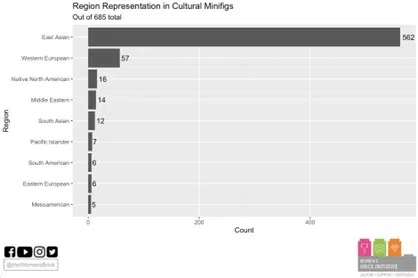
The bar chart below shows the gender distributions of minifigs by region. Since the overwhelming numbers of East Asian minifigs makes it difficult to compare the heights of the bars for the other regions, the second bar chart displays the same distributions, simply excluding the East Asian region.
We can see that for each region, male minifigs are the majority, and there are very few neutral minifigs across all regions.
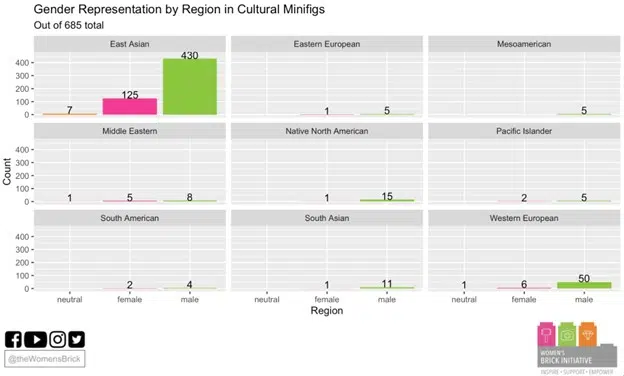
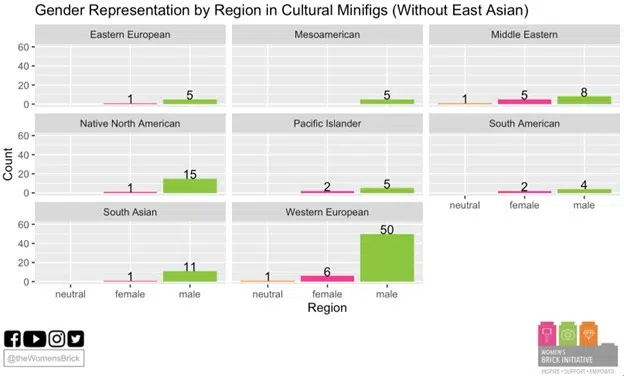
Excluding Ninjago and Monkie Kid
Excluding the Ninjago and Monkie Kid themes, there are a total of 183 cultural minifigs.
We can see from the bar chart below displaying the distribution by region that East Asian is still the region that has the most minifigs, and yet it is no longer leading by such an enormous number.
It is also notable that 37 of the 57 minifigs grouped into the Western European category are Vikings.
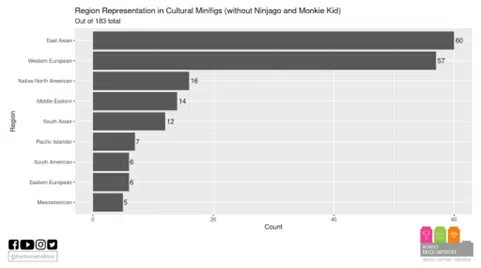
The line graph below provides an overview of the trends in release of cultural minifigs over time. We can see two major peaks in 2006 and 2020. In 2006-2007, 37 Viking minifigs were released, and in 2020, two Chinese New Year sets (Chinese New Year Temple Fair and Lion Dance) were released.
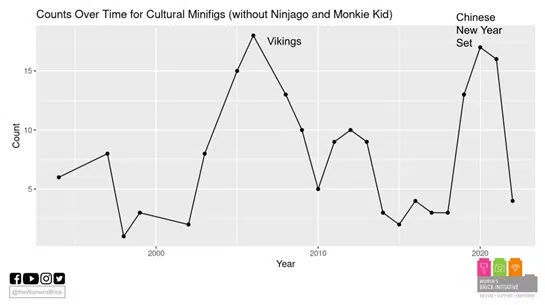
The bar charts below display the distribution of flesh tone colors used by region, with counts on the left and percentages on the right. It is notable that Eastern European is the only region that does not include any yellow. There are only 6 total minifigs in this region, however, and most of them are Russian or Ukrainian soldiers from the Indiana Jones theme. It is also interesting that we see the broadest diversity of flesh tones in MIddle Eastern minifigs. There is a Reddish Brown minifig in the Western European region which may seem a bit strange, but this is the Minotaur minifig, so it is not really a human.
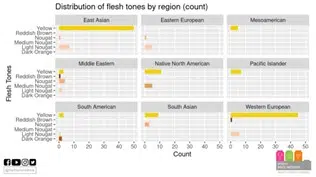
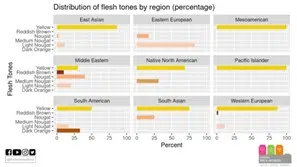
Ninjago
The Ninjago theme accompanies the LEGO Ninjago TV Series (2011-present) as well as the LEGO Ninjago Movie (2017), both of which are inspired by Japanese culture. There are a total of 702 minifigs in the Ninjago category and 93 in The LEGO Ninjago Movie category on BrickLink. However, many of the characters are non-human, and some are European and not Japanese. So, after filtering to only Japanese (or partially Japanese) human characters in both Ninjago categories, we ended up with a total of 448 minifigs for this section of the analysis. (Note: We did include a few non-human minifigs that were clearly inspired by Japanese culture, such as mannequins and statues).
Looking at the gender distribution for Ninjago minifigs as shown by the bar chart below, we see an extreme imbalance. There are over 4 times as many male minifigs as female minifigs, and only 5 minifigs that do not have an explicit gender, which are mainly the mannequins and statues.
WBI has conducted several previous analyses of gender imbalance in minifigs, yet this is an especially interesting theme to focus on, given that it is based on a TV series that LEGO themselves created. When looking at other themes based on TV shows or films, the gender imbalances in minifigs can often be attributed to choices made by the producers of the show or film. In this case, however, LEGO created the show and the minifigs, so it is clear that they chose to create this extreme gender imbalance.
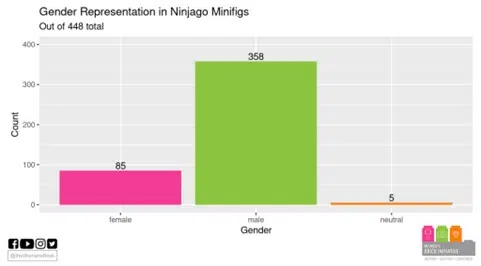
The line graph below shows an overview of the production of Ninjago minifigs over time. The large peak in 2017 is because of the LEGO Ninjago Movie having been released that year.
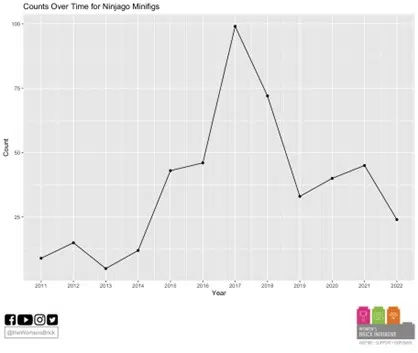
The line graphs below show trends in production over time split up by gender, with counts on the left and proportions on the right. We can see that the number of male minifigs released per year is consistently much higher than the number of female minifigs released per year. The disparity seems to improve a bit starting around 2014, and yet the percentage of female minifigs remains below 25% (proportion 0.25) for all years up through the present. We excluded neutral minifigs in the line graphs because there were so few of them that trends over time did not make sense to include.
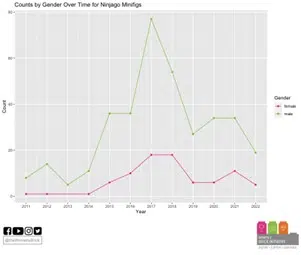
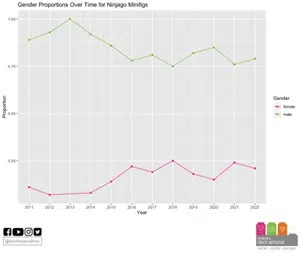
Monkie Kid
The Monkie Kid theme accompanies the relatively new LEGO Monkie Kid TV series (2020-present), which is based on Chinese culture. There are a total of 101 minifigs in the Monkie Kid category on BrickLink, and after filtering to only humans, we included 54 minifigs in this section of the analysis.
Comparing the gender distribution of minifigs to Ninjago, Monkie Kid is surprisingly much more equitable. As shown by the bar charts below showing aggregate counts by gender (left) and counts by gender by year (right), the overall counts are slightly imbalanced toward males, but the imbalance seems to have improved over time, and the gender split is exactly half male-half female in 2022 (so far). It will be interesting to see how this trend develops over future years given that the show is still new.
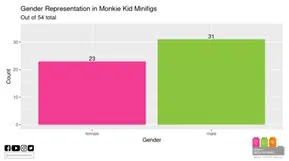
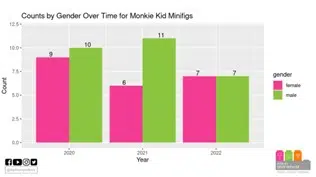
Cultural representation is a nuanced topic that requires qualitative analysis in addition to the numbers and graphs that we have presented here. This analysis offers a broad overview of which cultures are being represented within LEGO minifigs and the distributions of genders and flesh tone colors within these minifigs. It is clear that there is an abundance of East Asian and Western European minifigs, while all other areas of the world are extremely underrepresented. However, despite the large quantity of East Asian minifigs, this quantitative analysis alone does not tell us how accurately these minifigs represent East Asian individuals nor to what extent their design honors East Asian cultures. We can see from the flesh tone distributions that the vast majority of East Asian minifigs have yellow flesh tones, which may not be the most accurate color to use. This lack of flesh tone diversity is prevalent across almost all regions, and it appears that many cultural minifigs in general have flesh tones that do not match the flesh tones of individuals from that region. Furthermore, there is an extreme gender imbalance (toward males) across all cultural minifigs in every region. Given that most regions of the world have very few minifigs to begin with, diverse females and non-binary folks from around the world looking for minifigs representing them are even less likely to find a minifig with which they identify.
Stay tuned for [Part 2], where we will explore the nuances of cultural representation further through an analysis of how often heads used for cultural minifigs are repeated, and to what extent there is overlap between minifig heads across different cultures.
Note: Where does the data come from?
Since LEGO does not have a search method that enables one to navigate through all the existing cultural minifigures, we manually gathered our data by going over the categories and subcategories on BrickLink under Minifigures as well as Sets. As we went through these categories, we aimed to identify all human minifigs that were created with the intention of representing a specific culture. For example, minifigs in the Chinese New Year category were explicitly created to represent Chinese individuals, while minifigs in the Town category are meant to represent ‘generic’ people with no specific cultural identity.
The categories and subcategories we went through include:
- Adventurers
- Collectible Minifigures
- Series 1-22 Minifiguers
- Disney Series 1-2
- Promotional
- The LEGO Ninjago Movie
- Disney
- Aladdin
- Mulan
- Holiday & Event
- Chinese New Year
- Indiana Jones
- Long Ranger
- Lunar New Year
- Monkie Kid
- Ninjago
- Polynesian
- Super Heroes
- Shang-Chi
- The LEGO Ninjago Movie
- Vikings
- Western
- Wild West
We classified the minifigures into different cultures based on
- their clothings (torso descriptions),
- their hats (accessories),
- and any identifiable cultural heritage of the character that a specific minifig is representing, if applicable (if character name present in description).
From there, we ended up with 27 unique cultures, which we subsequently grouped together by broader geographical regions:
(Note that these culture classifications may be somewhat subjective and are by no means the only and “correct” geographical definition.)
- East Asian includes Chinese, Japanese, and Mongolian
- Western European includes British, German, Swedish, Roman, Viking, Irish, Greek, Scandinavian
- Native North American includes Native North American
- Middle Eastern includes Muslim/Islamic and Egyptian
- South Asian includes Indian and general South Asian
- Pacific Islander includes Polynesian and broader Pacific Islander
- South American includes general South American
- Eastern European includes Russian, Armenian, and Ukrainian
- Mesoamerican includes Mexican and Aztec


